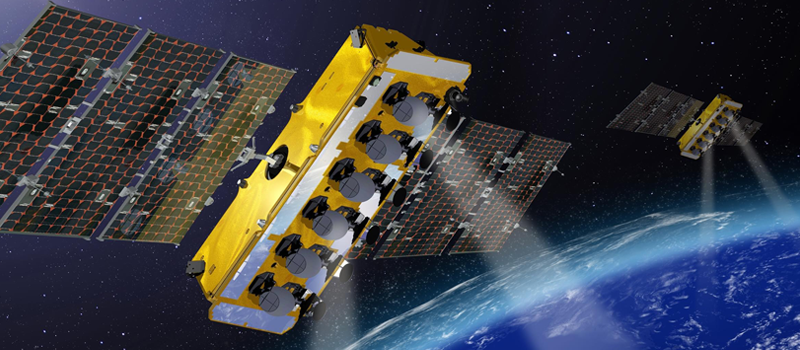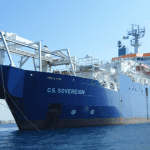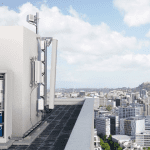
O3B satellites, courtesy of Thales Alenia Space
The Asia Pacific is home to the largest population in the globe and thus represents the largest addressable market for satellite services. The region is also as diverse geographically, ranging from countries as large as China and India that need ubiquitous networks, to small island nations in the South Pacific where the deployment of terrestrial solutions can prove to be impractical. In terms of connectivity, the Asia Pacific is likewise diverse with countries like Australia, China, Japan, South Korea, and Singapore enjoying high levels of broadband connectivity to laggards like the Philippines, Myanmar, and Cambodia registering among the lowest connectivity levels in the globe. Economically, Asia’s diversity is likewise highly pronounced where nations with high GDP per capita tend to register high connectivity levels, and those with low GDP commensurably register low connectivity levels.
Given geographical challenges, income disparity, and connectivity levels, the Asia Pacific seems the perfect place for offering game changing solutions that can bridge the digital divide that exists and one that has widened over time. One such offering, the LEO-HTS constellation, is but a few years before it becomes a reality.
Will they work for the Asia Pacific? O3b, a MEO-HTS program, is a good proxy. Looking at how the program has performed, the answer would appear to be yes, given the inroads of O3b in the Pacific Islands and other Asian countries for trunking and backhaul services as well as cruise ships and enterprise verticals.
Indeed, when combined under a “non-GEO-HTS” category, O3b in MEO and the LEO-HTS systems in terms of capacity demand for Broadband Access and Enterprise VSAT, provide high demand trajectories over the course of the 2016-2026 timeframe.
Elements for Success
For LEO-HTS, NSR believes there are five key components that have to be achieved to see if they will work.
First, get your house in order. Before we can assess if LEO-HTS systems will work, these systems have to launch first and foremost. Funding has to be achieved so satellites can be built, launched, and operated. Looking at the field of players, some are further along than others in this regard.
Second, ground terminal systems have to be ready when the constellations launch. And here, the antenna systems will be key. Taking O3b once again as a proxy, terminals supporting LEO-HTS systems will probably be ready but will likely be expensive. At this stage, there is still no inexpensive terminal that can be affordable to end customers for direct broadband access services. If current terminal developments and future offerings mirror O3b terminal equipment, LEO-HTS systems will be forced to target backhaul and trunking for telcos as well as high-end cruise ships and enterprise verticals. In NSR’s view, game change in the ground equipment side has to be achieved as well. Terminals must cost no more than USD 150 to USD 300 to be able to serve the mass markets.
Third, market access to country markets has to be obtained. If these constellations do launch and services can be offered but the regulatory regime has not been checked-off, all bets are off. Basically, market access via licenses or other market-entry arrangements are the ante, and without this element, LEO-HTS systems (and all other offerings for that matter) will fail. Basically, you have to be able to sell your services. And this is a very tricky component when looking at the Asia Pacific’s regulatory environment.
Fourth, bandwidth costs, service costs, and total cost of ownership have to come down. Competition within the satellite industry is healthy and bringing down costs leads to a larger market base. In addition, closing the gap with terrestrial services also opens up other opportunities that have remained unavailable or unaddressable historically for satellites.
Fifth, offering and developing new business cases has to be done. In the end, for LEO-HTS systems to work, these ventures have to be profitable. Based on the traditional offering of selling bandwidth in an evolving market dynamic that will be highly competitive, leading to lower and lower bandwidth prices, programs that need to be capitalized in the billions will not likely achieve positive ROI based on just selling bits on the wholesale play. Going down the value chain, offering value-added services, justifying premium pricing or contracts need to be developed.
Possible LEO-HTS Scenarios and Models
Partner with a Telco and Revenue Share– This is likely the closest to a wholesale model in terms of pure bandwidth leasing. In this arrangement, however, the LEO-HTS operator offers more than selling bits but provides value-added services, network management, integration with the core network, and other services in order to justify a revenue-sharing scheme and thus extract premium pricing.
Government Digital Divide Program– NBN Australia is a good example of this model where the government is the customer. The program is sustainable since there is a reliable and longstanding anchor tenant. However, what works for Australia may not work for other countries in the region. Programs and contracts can be cancelled with a change in administration.
Pure Market Play with Retail-like Offering– Offer low service costs achieved with low bandwidth costs, low equipment costs achieved via large orders that achieve economies of scale, and charged relatively low ARPU to customers to achieve high subscription rates. The challenge is in risking high volume orders for terminals, which adds to an already high CAPEX structure.
Bottom Line
LEO-HTS systems promising lower latency, higher quality of service, high bandwidth provisioning, lower bandwidth costs, and lower equipment costs will be attractive offerings not just for Asia but for all regions and countries where these services are available. However, the jury is still out on whether LEO-HTS systems will work. At least five key elements need to be addressed where all elements are of equal importance. There are also models that lead to sustainable business cases, but there are also risks and uncertainties. NSR believes there is a good to excellent probability that LEO-HTS systems will launch, thrive and succeed; however, not all systems being developed will be deployed. There is ample opportunity for LEO-HTS, but there is limited room for the number of players or offerings to thrive.
In the end, the large supply coming in with the feature of overall lower costs will be good for the region and in that sense, LEO-HTS systems will work in the Asia Pacific. However, the key challenge lies in the sustainability of LEO-HTS programs, and it is in the implementation of go-to-market strategies that will be key in determining if these individual systems will “work” in the region.




